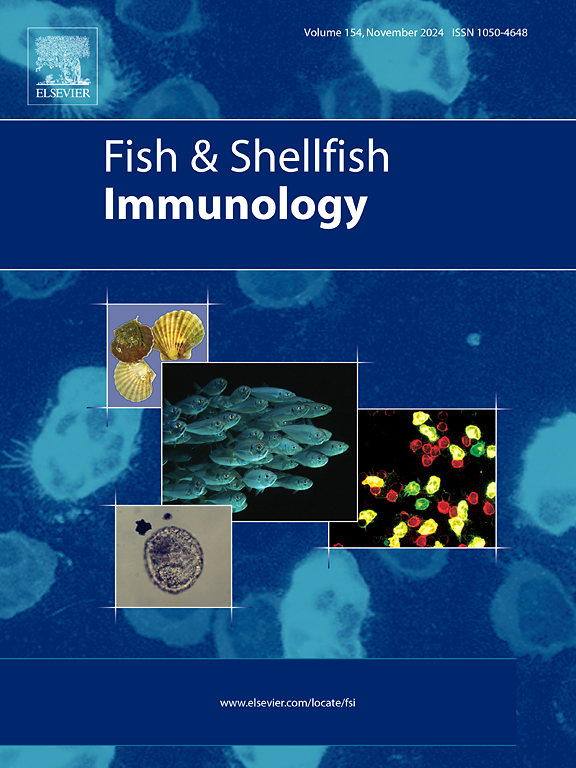大口鲈鱼(Micropterus salmoides)中五种鱼类特异性 CCR(CCR4La、CCR4Lc、CCR12a1、CCR12a2 和 CCR12b)的特征、表达和进化分析。
IF 4.1
2区 农林科学
Q1 FISHERIES
引用次数: 0
摘要
CC 趋化因子受体(CCR)是 G 蛋白偶联受体(GPCR)超家族中的一种,通过与其配体结合,在治疗感染、炎症和组织损伤方面发挥着至关重要的作用。本研究在大口鲈鱼(Micropterus salmoides)中发现了五种鱼类特异性 CCR,即 CCR4La、CCR4Lc、CCR12a1、CCR12a2 和 CCR12b。系统进化分析、结构分析和基因组同源分析证实了这些 CCRs 的命名更正。在感染 1×106 CFU/mL 和 1×107 CFU/mL Edwardsiella piscicida 后,这五种 CCRs 在大口鲈鱼脾脏中被显著诱导,表明它们在抗细菌感染的免疫反应中发挥着重要作用。选择压力分析表明,CCR4La、CCR4Lc、CCR12a1和CCR12a2经历了负选择压力,而CCR12b经历了正选择压力。稳健的选择位点检测方法发现,CCR4La、CCR4Lc、CCR12a1和CCR12a2的正选择位点主要分布在细胞外区域,参与配体结合和病原体相互作用。同样,CCR12b 的阳性选择位点也位于其细胞外区域。分子对接分析也验证了压力选择位点的准确性。通过分子对接分析确定了这五种CCR的潜在配体,发现CCL3和CCL5可能是大口鲈CCR4La/Lc的配体,CCL5、CCL8、CCL7、CCL13和CCL26可能是大口鲈CCR12a1/a2/b的配体。我们的研究结果为阐明大口鲈趋化因子-受体复合物的功能提供了依据。本文章由计算机程序翻译,如有差异,请以英文原文为准。
Characterization, expressional and evolutionary analysis of five fish-specific CCRs (CCR4La, CCR4Lc, CCR12a1, CCR12a2, and CCR12b) in largemouth bass (Micropterus salmoides)
CC chemokine receptors (CCRs), the numbers of the G protein-coupled receptor (GPCR) superfamily, had crucial roles in treating infection, inflammation, and tissue damage by binding to their ligands. In this study, five fish-specific CCRs, namely CCR4La, CCR4Lc, CCR12a1, CCR12a2, and CCR12b, were identified in largemouth bass (Micropterus salmoides). The correction of nomenclatures of these CCRs were confirmed by phylogenetic analysis, structural analysis and genomic synteny analysis. Following 1 × 106 CFU/mL and 1 × 107 CFU/mL Edwardsiella piscicida infection, these five CCRs were significantly induced in spleen of largemouth bass, indicating their important roles in the immune response against bacterial infection. Selection pressure analysis revealed that CCR4La, CCR4Lc, CCR12a1, and CCR12a2 underwent negative selection pressure, whereas CCR12b experienced positive selection pressure. Robust selection site detection methods identified that positive selected sites of CCR4La, CCR4Lc, CCR12a1, and CCR12a2 mainly distributed in their extracellular regions, which involved in ligand binding and pathogen interaction. Similarly, the positive selected sites of CCR12b were also located in its extracellular regions. The accuracy of the pressure selected sites were also validated by molecular docking analysis. The potential ligands for these five CCRs were identified by molecular docking analysis, with finding that CCL3 and CCL5 might be the ligands of largemouth bass CCR4La/Lc, and CCL5, CCL8, CCL7, CCL13 and CCL26 might be that of largemouth bass CCR12a1/a2/b. Our results provided basis for elucidating the functions of chemokine-receptor complex in largemouth bass.
求助全文
通过发布文献求助,成功后即可免费获取论文全文。
去求助
来源期刊

Fish & shellfish immunology
农林科学-海洋与淡水生物学
CiteScore
7.50
自引率
19.10%
发文量
750
审稿时长
68 days
期刊介绍:
Fish and Shellfish Immunology rapidly publishes high-quality, peer-refereed contributions in the expanding fields of fish and shellfish immunology. It presents studies on the basic mechanisms of both the specific and non-specific defense systems, the cells, tissues, and humoral factors involved, their dependence on environmental and intrinsic factors, response to pathogens, response to vaccination, and applied studies on the development of specific vaccines for use in the aquaculture industry.
 求助内容:
求助内容: 应助结果提醒方式:
应助结果提醒方式:


